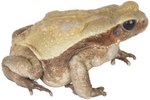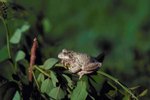
Frogs are members of the class Amphibia, which also includes toads, salamanders, newts and other animals that divide their time between land and water. Amphibians are the most endangered group of animals on Earth. According to Animal Planet, frogs are in a particularly perilous state, having lost approximately 170 species in the last 10 years. Presently, 1,900 frog species are threatened with extinction due to environmental dangers.
Invasive Species
Every year millions of animals are shipped around the world for use in labs, in zoos, for food or bait, or to keep as pets. Many of these animals are released or escape into environments in which they do not naturally occur. Once these invasive species successfully establish themselves and reproduce, they begin to prey upon endemic frog populations, consume their resources and spread disease. Invasive species are one of the biggest threats to native frog populations, and once they are established it is difficult to reverse the situation.
Habitat Loss
Frogs' habitats are altered by agricultural and infrastructure development. Swamps are drained, rivers are dammed, forests are cut down, housing and office buildings are erected, and frogs lose the resources they depend on for food, water, reproduction and shelter. Further, once a habitat is destroyed, the door is opened for increased predation by domestic animals and the introduction of disease.
Infectious Disease
According to Defenders of Wildlife, the chytrid fungus causes chytridiomycosis, a lethal skin disease that is responsible for the extinction of more than 100 species of frogs and other amphibians since the 1970s; it has caused declines in frog populations in 36 nations. The chytrid fungus spreads when an invasive, infected species is introduced into a habitat where native species have no immunity against the pathogen, causing an epidemic that results in population decline or extinction.
Toxic Chemicals
Fungicides, herbicides, pesticides and other toxic chemicals used in gardens and on crops are a major threat to frog populations. When these chemicals are sprayed, the wind and clouds carry them for miles, inevitably polluting formerly pristine waters, parks, woodlands and mountaintops. Frogs affected by these toxic substances can be stricken with immunosuppresion, sex reversal, hermaphroditism, delayed metamorphosis and death.
Global Trade
Save the Frogs estimates that millions of frogs are harvested each year for use as food, pets, lab dissection and bait. The trade in frog legs alone is colossal and extends to just about every corner of the globe. For example, Indonesia, which is responsible for 45 percent of the world's trade in frog legs, exports an estimated 4,000 tons of frog legs each year. This unchecked harvesting of native species is a major contributor to population decline and extinction.
Climate Changes
As scientists continue to debate whether climate changes are human-induced or part of our planet's natural cycles, it seems there's no doubt that changes in climate adversely affect frogs. Terrestrial frogs inhabiting tropical mountain ranges are the most negatively affected. As their habitats dry up, they're forced to move further up the mountainsides to find environments moist enough to lay their eggs. However, when habitats on the mountaintops dry up, there is nowhere left for them to go.
References
Resources
Photo Credits
-
Jupiterimages/liquidlibrary/Getty Images
Writer Bio
Yvette Sajem has been a professional writer since 1995. Her work includes greeting cards and two children's books. A lifelong animal advocate, she is active in animal rescue and transport, and is particularly partial to senior and special needs animals.




